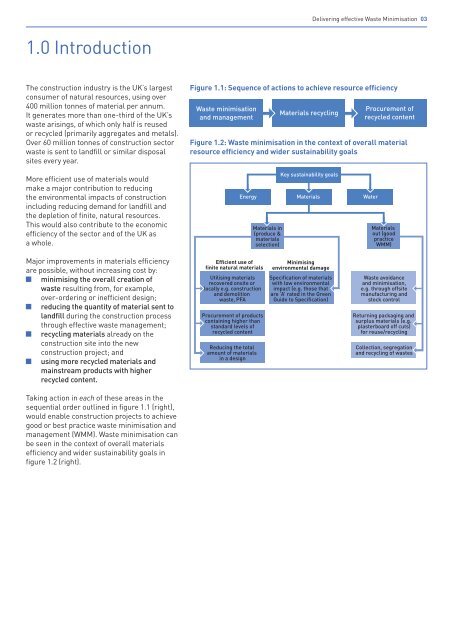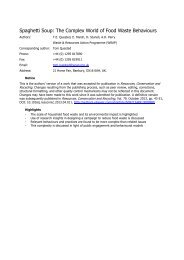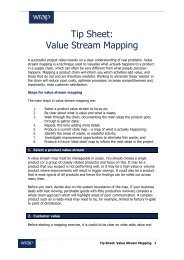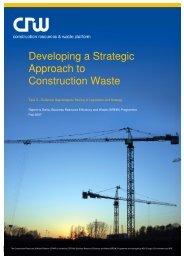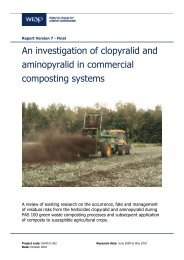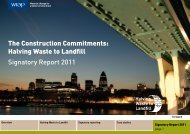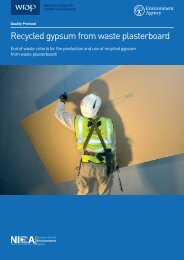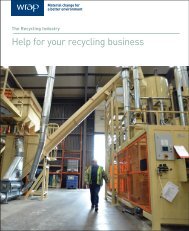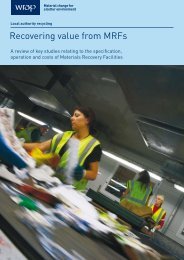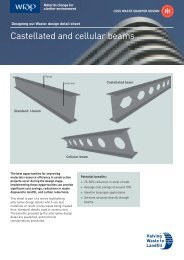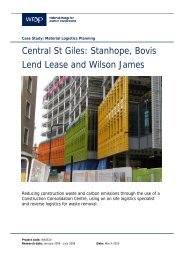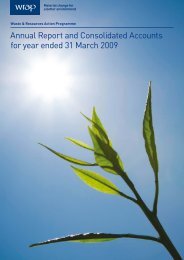Delivering effective Waste Minimisation - Wrap
Delivering effective Waste Minimisation - Wrap
Delivering effective Waste Minimisation - Wrap
You also want an ePaper? Increase the reach of your titles
YUMPU automatically turns print PDFs into web optimized ePapers that Google loves.
<strong>Delivering</strong> <strong>effective</strong> <strong>Waste</strong> <strong>Minimisation</strong> 03<br />
1.0 Introduction<br />
The construction industry is the UK’s largest<br />
consumer of natural resources, using over<br />
400 million tonnes of material per annum.<br />
It generates more than one-third of the UK’s<br />
waste arisings, of which only half is reused<br />
or recycled (primarily aggregates and metals).<br />
Over 60 million tonnes of construction sector<br />
waste is sent to landfill or similar disposal<br />
sites every year.<br />
Figure 1.1: Sequence of actions to achieve resource efficiency<br />
<strong>Waste</strong> minimisation<br />
and management<br />
Materials recycling<br />
Procurement of<br />
recycled content<br />
Figure 1.2: <strong>Waste</strong> minimisation in the context of overall material<br />
resource efficiency and wider sustainability goals<br />
More efficient use of materials would<br />
make a major contribution to reducing<br />
the environmental impacts of construction<br />
including reducing demand for landfill and<br />
the depletion of finite, natural resources.<br />
This would also contribute to the economic<br />
efficiency of the sector and of the UK as<br />
a whole.<br />
Energy<br />
Materials in<br />
(produce &<br />
materials<br />
selection)<br />
Key sustainability goals<br />
Materials<br />
Water<br />
Materials<br />
out (good<br />
practice<br />
WMM)<br />
Major improvements in materials efficiency<br />
are possible, without increasing cost by:<br />
minimising the overall creation of<br />
waste resulting from, for example,<br />
over-ordering or inefficient design;<br />
reducing the quantity of material sent to<br />
landfill during the construction process<br />
through <strong>effective</strong> waste management;<br />
recycling materials already on the<br />
construction site into the new<br />
construction project; and<br />
using more recycled materials and<br />
mainstream products with higher<br />
recycled content.<br />
Efficient use of<br />
finite natural materials<br />
Utilising materials<br />
recovered onsite or<br />
locally e.g. construction<br />
and demolition<br />
waste, PFA<br />
Procurement of products<br />
containing higher than<br />
standard levels of<br />
recycled content<br />
Reducing the total<br />
amount of materials<br />
in a design<br />
Minimising<br />
environmental damage<br />
Specification of materials<br />
with low environmental<br />
impact (e.g. those that<br />
are ‘A’ rated in the Green<br />
Guide to Specification)<br />
<strong>Waste</strong> avoidance<br />
and minimisation,<br />
e.g. through offsite<br />
manufacturing and<br />
stock control<br />
Returning packaging and<br />
surplus materials (e.g.<br />
plasterboard off cuts)<br />
for reuse/recycling<br />
Collection, segregation<br />
and recycling of wastes<br />
Taking action in each of these areas in the<br />
sequential order outlined in figure 1.1 (right),<br />
would enable construction projects to achieve<br />
good or best practice waste minimisation and<br />
management (WMM). <strong>Waste</strong> minimisation can<br />
be seen in the context of overall materials<br />
efficiency and wider sustainability goals in<br />
figure 1.2 (right).


